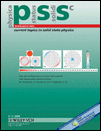Intrinsic mechanism of anomalous Hall effect in a twodimensional magnetic system with impurities
Abstract
We report some new results on the Anomalous Hall effect induced by the Berry phase in momentum space. Our main calculations are performed within the model of a two-dimensional electron gas with the spin-orbit interaction of Rashba type, taking into account the scattering from impurities. We demonstrate that such an “intrinsic” mechanism can really dominate but there is a competition between the geometric Berry-phaseinduced term σ II xy in the Hall conductivity and the impurity-induced term σ I xy , related to the contribution of the states in the vicinity of the Fermi surface. We also show that the contribution to the Hall conductivity from the electron states close to the Fermi surface has the intrinsic property as well, and it does not vanish in the clean limit. The main effect of the impurity-related contribution is a possible change of sign of the off-diagonal conductivity. The resulting magnitude and sign of the Hall conductivity strongly depend on the electron density in the system. (© 2006 WILEY-VCH Verlag GmbH & Co. KGaA, Weinheim)




